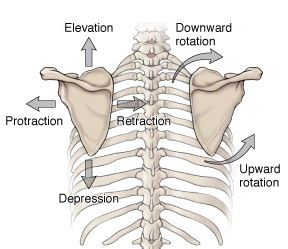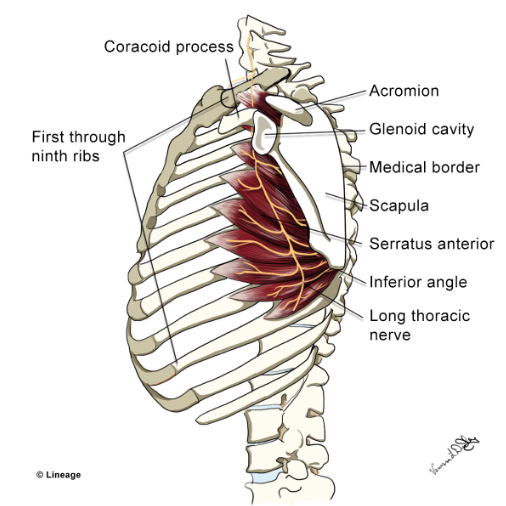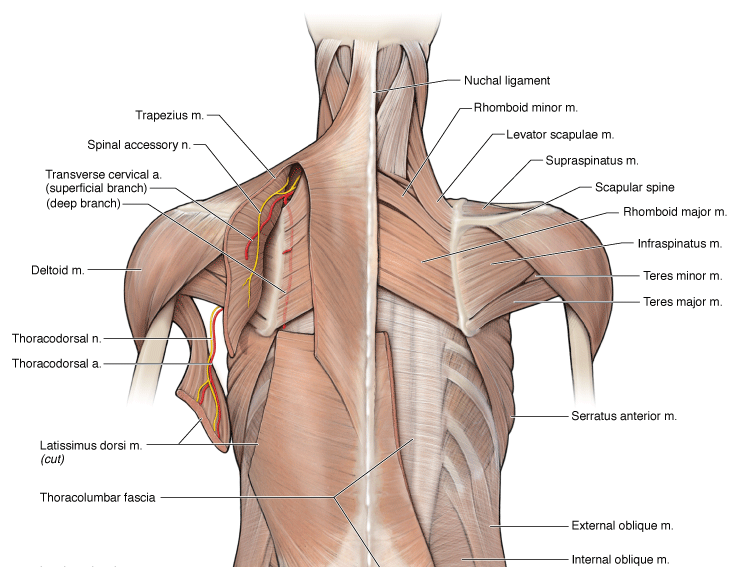Superficial Muscles of the Back
Muscle |
Proximal Attachment |
Distal Attachment |
Action |
Innervation |
|---|---|---|---|---|
Trapezius |
Occipital bone, nuchal ligament, C7–T12 vertebrae |
Clavicle, acromion, and spine of scapula |
Elevates, retracts, depresses, and rotates scapula |
Spinal root of accessory n. (CN XI) and cervical nn. (C3–C4) |
Levator scapulae |
Transverse processes of C1–C4 vertebrae |
Superior angle of scapula |
Elevates and rotates scapula; inclines neck to same side of contraction |
Cervical nn. (C3–C4) and dorsal scapular n. (C5) |
Rhomboid major |
Spinous processes of T2–T5 vertebrae |
Medial margin of scapula |
Retract and rotate scapula |
Dorsal scapular n. (C4–C5) |
Rhomboid minor |
Spinous processes of C7–T1 vertebrae |
Medial margin of scapula |
Retract and rotate scapula |
Dorsal scapular n. (C4–C5) |
Latissimus dorsi |
T7 sacrum, thoracolumbar fascia, iliac crest, and inferior 3 ribs |
Intertubercular groove of humerus |
Extends, adducts, and medially rotates humerus |
Thoracodorsal n. (C6–C8) |
Trapezius Muscle
The trapezius muscle is the most superficial back muscle. It attaches to the occipital bone, nuchal ligament, spinous processes of C7–T12, scapular spine, acromion, and clavicle. The trapezius muscle has a triangular shape and has the following muscle fiber orientations:
- Superior fibers. Course obliquely from the occipital bone and upper nuchal ligament to the scapula, causing scapular elevation and upward rotation.
- Middle fibers. Course horizontally from the lower nuchal ligament and thoracic vertebrae to the scapula, causing scapular retraction.
- Inferior fibers. Course superiorly from the lower thoracic vertebrae to the scapula, causing scapular depression and upward rotation.
In addition, the multiple fiber orientation of the trapezius muscle fixes the scapula to the posterior wall of the thorax during upper limb movement. It is innervated by the spinal accessory nerve (CN XI). The superficial branch of the transverse cervical artery supplies the trapezius muscle, whereas the deep branch of the transverse cervical artery supplies the levator scapulae and rhomboid muscles. In some instances, the dorsal scapular artery will replace the deep branch of the transverse cervical artery.
Levator Scapulae Muscle
The levator scapula muscle is located deep to the trapezius muscle and superior to the rhomboids. The levator scapula muscle attaches to the cervical vertebrae and the superior angle of the scapula, causing elevation and downward rotation of the scapula. The nerve supply is from branches of ventral rami from spinal nerves C3–C4 and occasionally from C5, via the dorsal scapular nerve, and vascular supply is from the deep branch of the transverse cervical artery.
Rhomboid Major and Minor Muscles
The rhomboid minor is superior to the rhomboid major, with both positioned deep to the trapezius muscle. The rhomboid muscles attach to the spinous processes of C7–T5 and the medial border of the scapula, resulting in scapular retraction. They are innervated by the dorsal scapular nerve (i.e., the ventral ramus of C5) and the vascular supply from the deep branch of the transverse cervical artery.
Latissimus Dorsi Muscle
The latissimus dorsi is a broad, flat muscle of the lower region of the back. It attaches to the spinous processes of T7, inferior to the sacrum via the thoracolumbar fascia, and inserts laterally into the intertubercular groove of the humerus. The latissimus dorsi acts on the humerus (arm) causing powerful adduction, extension, and medial rotation of the arm. It is innervated by the thoracodorsal nerve (ventral rami of C6–C8) and receives its blood supply from the thoracodorsal artery (branch off the axillary artery).
Scapular Movements
The scapula glides over the thoracic wall, but there are no distinct anatomic joints). Instead, muscles pull the scapula forward and backward (protraction and retraction, respectively) and up and down (elevation and depression, respectively) and rotate it so that the glenoid fossa moves superiorly (upward rotation) or inferiorly (downward rotation). Rotation of the scapula is defined by the direction that the glenoid fossa faces.


